
Sumatra is one of the Sunda Islands of western Indonesia. It is the largest island that is fully within Indonesian territory, as well as the sixth-largest island in the world at 473,481 km2 (182,812 mi.2), not including adjacent islands such as the Simeulue, Nias, Mentawai, Enggano, Riau Islands, Bangka Belitung and Krakatoa archipelago.

Riau is a province of Indonesia. It is located in the central eastern coast of Sumatra along the Strait of Malacca. Until 2004 the province included the offshore Riau Islands, a large group of small islands located east of Sumatra Island and south of Singapore, before these islands were split off as a province in July 2004. The provincial capital and the largest city of Riau is Pekanbaru. The province shares land borders with North Sumatra to the northwest, West Sumatra to the west, and Jambi to the south. The total area for Riau province is 87,023.66 square kilometres (33,600.02 sq mi), which stretches from the slopes of the Bukit Barisan to the Strait of Malacca. Riau has a wet tropical climate with average rainfall ranging between 2000 and 3000 millimeters per year, and the average rainfall per year is about 160 days. Riau is currently one of the richest provinces in Indonesia and is rich in natural resources, particularly petroleum, natural gas, rubber, palm oil and fibre plantations. Extensive logging and plantation development in has led to a massive decline in forest cover Riau, and associated fires have contributed to haze across the larger region.

West Sumatra is a province of Indonesia. On the west coast of the island of Sumatra, the province has an area of 42,012.89 km2, and it had a population of 4,846,909 at the 2010 Census and 5,534,472 at the 2020 Census. The province includes the Mentawai Islands off the coast and borders the provinces of North Sumatra to the north, Riau and Jambi to the east, and Bengkulu to the southeast. West Sumatra is sub-divided into twelve regencies and seven cities. It has relatively more cities than other provinces outside of Java, although several of them are relatively low in population compared with cities elsewhere in Indonesia. Padang is the province's capital and largest city.
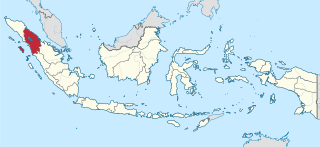
North Sumatra is a province of Indonesia located on the northern part of the island of Sumatra. Its capital and largest city is Medan. North Sumatra is the fourth most-populous province after West Java, East Java and Central Java. The province covers an area of 72,981 km2. According to the 2020 population census, the province had a population of 14,799,361.

South Sumatra is a province of Indonesia. It is located on the southeast of the island of Sumatra, The province spans 91,592.43 km2 (35,364 sq mi) and had a population of 8,467,432 at the 2020 Census. The capital of the province is Palembang. The province borders the provinces of Jambi to the north, Bengkulu to the west and Lampung to the south. The Bangka Strait in the east separates South Sumatra and the island of Bangka, which is part of the Bangka Belitung Islands province. This province is rich in natural resources, such as petroleum, natural gas and coal. The province is inhabited by many different ethnic groups, with Palembang people the largest ethnic group. Most speak Palembang Malay, which is mutually unintelligible to both Indonesian and Standard Malay. Other ethnic groups include the Javanese, Sundanese, Minangkabau and Chinese. Most are concentrated in urban areas and are largely immigrants from other parts of Indonesia.
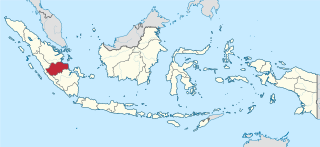
Jambi is a province of Indonesia. It is located on the east coast of central Sumatra and spans to the Barisan Mountains in the west. Its capital and largest city is Jambi. The province has a land area of 50,160.05 km2, and a sea area of 3,274.95 km2. It had a population of 3,092,265 according to the 2010 Census and 3,548,228 according to the 2020 Census.

The culture of Indonesia has been shaped by long interaction between original indigenous customs and multiple foreign influences. Indonesia is centrally-located along ancient trading routes between the Far East, South Asia and the Middle East, resulting in many cultural practices being strongly influenced by a multitude of religions, including Buddhism, Christianity, Confucianism, Hinduism, and Islam, all strong in the major trading cities. The result is a complex cultural mixture very different from the original indigenous cultures.
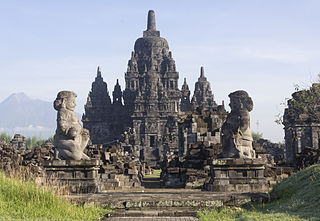
A Buddhist temple or Buddhist monastery is the place of worship for Buddhists, the followers of Buddhism. They include the structures called vihara, chaitya, stupa, wat and pagoda in different regions and languages. Temples in Buddhism represent the pure land or pure environment of a Buddha. Traditional Buddhist temples are designed to inspire inner and outer peace.

Malay houses refer to the vernacular dwellings of the Malays, an ethno-linguistic group inhabiting Sumatra, coastal Borneo and the Malay Peninsula.

Taman Mini "Indonesia Indah" is a culture-based recreational area located in East Jakarta, Indonesia. Since July 2021, it is operated by the Government of Indonesia through the PT Taman Wisata Candi Borobudur, Prambanan, dan Ratu Boko; it was formerly operated by Yayasan Harapan Kita, a foundation established by Siti Hartinah, the first lady during most of the New Order and wife of Suharto, and still run by Suharto's descendants since his death. It has an area of about 100 hectares.

The architecture of Indonesia reflects the diversity of cultural, historical and geographic influences that have shaped Indonesia as a whole. Invaders, colonizers, missionaries, merchants and traders brought cultural changes that had a profound effect on building styles and techniques.

Dance in Indonesia reflects the country's diversity of ethnicities and cultures. There are more than 1,300 ethnic groups in Indonesia. Austronesian roots and Melanesian tribal forms are visible, and influences ranging from neighboring Asian and even western styles through colonization. Each ethnic group has its own dances: there are more than 3,000 original dance forms in Indonesia. The old traditions of dance and drama are being preserved in the many dance schools which flourish not only in the courts but also in the modern, government-run or supervised art academies.
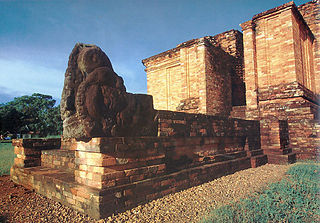
Muaro Jambi is a Buddhist temple complex, in Muaro Jambi Regency, Jambi province, Sumatra, Indonesia. It is situated 26 kilometers east from the city of Jambi. The temple complex was built by the Melayu Kingdom, with its surviving temples and other archaeological remains estimated to date from the 7th to 13th century CE. The archaeological site includes eight excavated temple sanctuaries and covers about 12 square kilometers, stretches 7.5 kilometers along the Batang Hari River, 80 menapos or mounds of temple ruins, are not yet restored. It is one of the largest and best-preserved ancient temple complexes in South East Asia.

Malay Indonesians are ethnic Malays living throughout Indonesia. They are one of the indigenous peoples of the country. Indonesian, the national language of Indonesia, is a standardized form of Riau Malay. There were numerous Malay kingdoms in what is now Indonesia, mainly on the islands of Borneo and Sumatra. These included Srivijaya, the Melayu Kingdom, Dharmasraya, the Sultanate of Deli, the Sultanate of Siak Sri Indrapura, the Riau-Lingga Sultanate, the Sultanate of Bulungan, Pontianak Sultanate, and the Sultanate of Sambas.

Rumah adat are traditional houses built in any of the vernacular architecture styles of Indonesia, collectively belonging to the Austronesian architecture. The traditional houses and settlements of the several hundreds ethnic groups of Indonesia are extremely varied and all have their own specific history. It is the Indonesian variants of the whole Austronesian architecture found all over places where Austronesian people inhabited from the Pacific to Madagascar each having their own history, culture and style.

The national costume of Indonesia is the national costume that represents the Republic of Indonesia. It is derived from Indonesian culture and Indonesian traditional textile traditions. Today the most widely recognized Indonesian national costumes include batik and kebaya, although originally those costumes mainly belong within the island of Java and Bali, most prominently within Javanese, Sundanese and Balinese culture. Since Java has been the political and population center of Indonesia, folk costume from the island has become elevated into national status.
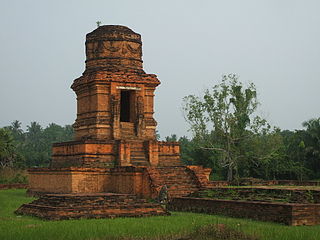
Candi Bahal, also known as Biaro Bahal or Candi Portibi is Vajrayana Buddhist candi complex in Bahal village, Padang Bolak, Portibi, Padang Lawas Regency, North Sumatra, Indonesia. It is located about three hours journey with car from Padangsidempuan or 400 km from Medan. The complex includes three candis: Candi Bahal I, Candi Bahal II, and Candi Bahal III. The temple site is linked to Pannai Kingdom circa 11th to 13th century CE.

Mosque architecture in Indonesia refers to the architectural traditions of mosques built in the archipelago of Indonesia. Initial forms of the mosque, for example, were predominantly built in the vernacular Indonesian architectural style mixed with Hindu, Buddhist or Chinese architectural elements, and notably didn't equip orthodox form of Islamic architectural elements such as dome and minaret. Vernacular architectural style varies depending on the island and region.
Bumiayu temple compound, or locally known as Candi Bumiayu, is a Sumatran Shivaist Hindu temple complex located near the banks of Lematang river, precisely in Bumiayu village, Tanah Abang district, Penukal Abab Lematang Ilir Regency, South Sumatra, Indonesia. The temple located about 120 kilometres west of Palembang city. The red brick structures are estimated dated from 8th to 13th-century, and linked to the Srivijaya kingdom. Compared to Java, only a few Hindu-Buddhist temple ruins has been rediscovered in Sumatra. The temple is known as one of the few surviving Hindu temple remnant in South Sumatra. Other temple ruins in Sumatra are Muaro Jambi in Jambi, Muara Takus in Riau, and Bahal temple in North Sumatra.




















